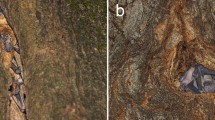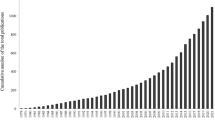Abstract
The oriental fruit fly and its relatives, Bactrocera dorsalis complex Hendel (Diptera: Tephritidae) were eradicated from the islands of Okinawa Prefecture, southwestern Japan, in 1986. Since just after the eradication, however, re-invasion of B. dorsalis complex has been continuing to date, and the cause of the re-invasion has not been fully analyzed yet. It is believed that there are two possible routes of the re-invasion: wind-borne immigration and importation of infested fruits. This study analyzed the former natural factor by calculating backward trajectories for B. dorsalis complex males caught in monitoring traps from 1986 to 2012. In 65.8 % of the total re-invasion events, trajectories could be traced to at least one of the insect’s native regions: Taiwan (71.8 %), the Philippines (24.3 %) and southern China (3.9 %). In these possible immigration events, the influencing meteorological factors were found to be fronts (44.6 %), typhoons (36.0 %), high-pressure system ridges (12.0 %) and tropical depressions (7.5 %). The number of insects caught per trap was found to greater on the islands near the estimated sources than those further from the sources, supporting the hypothesis of wind-borne immigration of B. dorsalis complex into Okinawa.







Similar content being viewed by others
References
Chen WS, Chen SK, Chang HY (2002) Study on the population dynamics and control tactics of the oriental fruit fly (Bactrocera dorsalis (Hendel)). Plant Prot Bull 44:267–278 (in Chinese)
Chen CC, Dong YJ, Li CT, Liu KY, Cheng LL (2006a) Movement of the oriental fruit fly, Bactrocera dorsalis (Hendel) (Diptera: Tephritidae), in a guava orchard with special reference to its population changes. Formos Entomol 26:143–159
Chen P, Ye H, Liu JH (2006b) Population dynamics of Bactrocera dorsalis (Diptera: Tephritidae) along with analysis on the factors influencing the population in Ruili, Yunnan Province. Acta Ecol Sin 26:2801–2809 (in Chinese)
Christenson LD, Foote RH (1960) Biology of fruit flies. Ann Rev Entomol 5:171–192. doi:10.1146/annurev.en.05.010160.001131
Clarke AR, Armstrong KF, Carmichael AE, Milne JR, Raghu S, Roderick GK, Yates DK (2005) Invasive phytophagous pests arising through a recent tropical evolutionary radiation: the Bactrocera dorsalis complex of fruit flies. Ann Rev Entomol 50:293–319. doi:10.1146/annurev.ento.50.071803.130428
Department of Agriculture, Forestry and Fisheries (1994) A memorial book for fruit-fly eradications on Okinawa. Okinawa Prefectural Government, Naha (in Japanese)
Drake VA, Reynolds DR (2012) Radar entomology: observing insect flight and migration. CAB International, Oxfordshire
Draxler RR (1999) HYSPLIT4 user’s guide. NOAA Tech. Memo. ERL ARL-230. NOAA Air Resources Laboratory, Silver Spring
Draxler RR, Hess GD (1997) Description of the HYSPLIT_4 modeling system. NOAA Tech. Memo. ERL ARL-224. NOAA Air Resources Laboratory, Silver Spring
Draxler RR, Rolph GD (2014) HYSPLIT (HYbrid Single-Particle Lagrangian Integrated Trajectory) model. http://ready.arl.noaa.gov/HYSPLIT.php. Accessed 1 Aug 2014
Drew RAI, Hancock DL (1994) The Bactrocera dorsalis complex of fruit flies (Diptera: Tephritidae: Dacinae) in Asia. Bull Entomol Res Suppl 2:1–68. doi:10.1017/S1367426900000278
Fletcher BS (1987) The biology of Dacine fruit flies. Ann Rev Entomol 32:115–144. doi:10.1146/annurev.en.32.010187.000555
Froerer KM, Peck SL, McQuate GT, Vargas RI, Jang EB, Mclnnis DO (2010) Long-distance movement of Bactrocera dorsalis (Diptera: Tephritidae) in Puna, Hawaii: how far can they go? Am Entomol 56:88–94
Hirabayashi C, Komori K, Shiroma Y, Okamoto M, Hamagami A (2012) Comparison of flight ability of solanum fruit fly, Bactrocera latifrons (Diptera: Tephritidae) and oriental fruit fly, Bactrocera dorsalis (Diptera: Tephritidae). Res Bull Plant Prot Jpn 48:19–26 (in Japanese)
Hsu JC, Feng HT (2000) Insecticide susceptibility of the oriental fruit fly (Bactrocera dorsalis (Hendel)) (Diptera: Tephritidae) in Taiwan. Chin J Entomol 20:109–118
Huang SQ, Han RC (2005) Advance in the research on the quarantine pest Bactrocera dorsalis. Chin Bull Entomol 42:479–484 (in Chinese)
Huang TC, Cheng EY, Kao CH, Hwang YB, Chiang MY (2006) Area-wide control of the oriental fruit fly and melon fly in Taiwan. In: Proceedings of International Symposium on Area-Wide Management of Insect Pests. Food and Fertilizer Technology Center for the Asian and Pacific Region, Taipei, Okinawa Prefectural Agricultural Research Center, Okinawa, p 137–146
Huang YY, Chen J, Shen JF, Cai HJ (2008) The trap efficiency of different traps and baits on Bactrocera dorsalis. Chin Agri Sci Bull 24:390–392 (in Chinese)
Jiang JA, Tseng CL, Lu FM et al (2008) A GSM-based remote wireless automatic monitoring system for field information: a case study for ecological monitoring of the oriental fruit fly, Bactrocera dorsalis (Hendel). Comput Electron Agric 62:243–259. doi:10.1016/j.compag.2008.01.005
Kalnay E, Kanamitsu M, Kistler R et al (1996) The NMC/NCAR 40-year reanalysis project. Bull Am Meteorol Soc 77:437–471. doi:10.1175/1520-0477(1996)077<0437:TNYRP>2.0.CO;2
Kiritani K (2012) The low development threshold temperature and the thermal constant in insects and mites in Japan (2nd edition). Bull Natl Inst Agro-Environ Sci 31:1–74 (in Japanese)
Kohama T, Yoshida S, Yamashiro T (2001) The host plants of Bactrocera dorsalis, Bactrocera cucurbitae and Bactrocera latifrons in Okinawa, Japan. Fruit Fly Eradication Project Office, Okinawa Prefectural Government, Naha (in Japanese)
Koyama J, Teruya T, Tanaka K (1984) Eradication of the oriental fruit fly (Diptera: Tephritidae) from the Okinawa Islands by a male annihilation method. J Econ Entomol 77:468–472
Liang F, Wu JJ, Liang GQ (2001) The first report of the test on the flight ability of oriental fruit fly. Acta Agric Univ Jiangxiensis 23:259–260 (in Chinese)
Liu JH, Ye H (2006) Effect of light, temperature and humidity on the flight activities of the oriental fruit fly, Bactrocera dorsalis. Chin Bull Entomol 43:211–214 (in Chinese)
Manoto, EC (1991) Status of the fruit fly control program in the Philippines. In Kawasaki K et al. (ed) Proceedings of the International Symposium on the Biology and Control of Fruit Flies. Food and Fertilizer Technology Center, Taipei, University of the Ryukyus, Nishihara, and Okinawa Prefectural Government, Naha, p 87–97
Muraji M, Nakahara S, Ishida T, Minoura K, Miyazaki I, Kohama T (2008) The Philippines is a possible source of the Bactrocera dorsalis complex species (Diptera: Tephritidae) occasionally collected in the Ryukyu Islands of Japan; analyses of mitochondrial DNA. Appl Entomol Zool 43:609–615. doi:10.1303/aez.2008.609
Nakamori H, Nishimura M, Kakinohana H (1991) Eradication of the oriental fruit fly, Dacus dorsalis Hendel (Diptera: Tephritidae), from Miyako and Yaeyama Islands by the male annihilation method. In: Vijaysegaran S, Ibrahim AG (eds) Fruit flies in the tropics: proceedings of the first International Symposium Malaysian Agricultural Research and Development Institute. Malaysian Plant Protection Society, Kuala Lumpur, pp 220–231
Ohno S, Tamura Y (2008) First detection of the fruit fly Bactrocera synnephes (Diptera: Tephritidae) on Iriomote Island, south-western Japan. Entomol Sci 11:105–110. doi:10.1111/j.1479-8298.2007.00251.x
Ohno S, Tamura Y, Haraguchi D, Kohama T (2008) First detection of the pest fruit fly, Bactrocera tau (Diptera: Tephritidae), in the field in Japan: evidence of multiple invasions of Ishigaki Island and failure of colonization. Appl Entomol Zool 43:541–545. doi:10.1303/aez.2008.541
Ohno S, Tamura Y, Haraguchi D, Matsuyama T, Kohama T (2009) Re-invasion by Bactrocera dorsalis complex (Diptera: Tephritidae) occurred after its eradication in Okinawa, Japan, and local differences found in the frequency and temporal patterns of invasions. Appl Entomol Zool 44:643–654. doi:10.1303/aez.2009.643
Otuka A, Nagayoshi K (2015) Immigration analysis system of the oriental fruit fly, Bactrocera dorsalis complex Hendel (Diptera: Tephritidae), for Okinawa Prefecture, southwestern Japan. Agric Inf Res 24:23–34. doi:10.3173/air.24.23
Otuka A, Dudhia J, Watanabe T, Furuno A (2005a) A new trajectory analysis method for migratory planthoppers, Sogatella furcifera (Horváth) (Homoptera: Delphacidae) and Nilaparvata lugens (Stål), using an advanced weather forecast model. Agric For Entomol 7:1–9. doi:10.1111/j.1461-9555.2005.00236.x
Otuka A, Watanabe T, Suzuki Y, Matsumura M (2005b) Estimation of the migration source for the white-backed planthopper Sogatella furcifera (Horváth) (Homoptera: Delphacidae) immigrating into Kyushu in June. Jpn J Appl Entomol Zool 49:187–194. doi:10.1303/jjaez.2005.187
Otuka A, Watanabe T, Suzuki Y, Matsumura M, Furuno A, Chino M (2005c) Real-time prediction system for migration of rice planthoppers Sogatella furcifera (Horváth) and Nilaparvata lugens (Stål) (Homoptera: Delphacidae). Appl Entomol Zool 40:221–229. doi:10.1303/aez.2005.221
Otuka A, Zhou Y, Lee GS, Matsumura M, Zhu Y, Park HH, Liu Z, Sanada-Morimura S (2012) Prediction of overseas migration of the small brown planthopper, Laodelphax striatellus (Hemiptera: Delphacidae) in East Asia. Appl Entomol Zool 47:379–388. doi:10.1007/s13355-012-0130-x
Schutze MK, Aketarawong N, Amornsak W, Armstrong KF, Augustinos AA, Barr N, Bo W, Bourtzis K, Boykin LM, Cáceres C, Cameron SL, Chapman TA, Chinvinijkul S, Chomič A, De Meyer M, Drosopoulou E, Englezou A, Ekesi S, Gariou-Papalexiou A, Geib SM, Hailstones D, Hasanuzzaman M, Haymer D, Hee AKW, Hendrichs J, Jessup A, Ji Q, Khamis FM, Krosch MN, Leblanc L, Mahmood K, Malacrida AR, Mavragani-Tsipidou P, Mwatawala M, Nishida R, Ono H, Reyes J, Rubinoff D, San Jose M, Shelly TE, Srikachar S, Tan KH, Thanaphum S, Ul-Haq I, Vijaysegaran S, Wee SL, Yesmin F, Zacharopoulou A, Clarke AR (2014) Synonymization of key pest species within the Bactrocera dorsalis species complex (Diptera: 3 Tephritidae): taxonomic changes based on 20 years of integrative morphological, molecular, 4 cytogenetic, behavioral, and chemoecological data. Syst Entomol. doi:10.1111/syen.12113
Steiner LF (1957) Low-cost plastic fruit fly trap. J Econ Entomol 50:508–509
Wan X, Liu Y, Zhang B (2012) Invasive history of the oriental fruit fly, Bactrocera dorsalis, in the Pacific-Asia region: two main invasive routes. PLoS One 7:e36176. doi:10.1371/jounal.pone.0036176
Yang L, Huang WJ, Huang LF, Wang WL, Jiang JJ (2014) Research and development on invaded insect Bactrocera dorsalis for detection method. J Agric 4:19–21 (in Chinese)
Ye H, Liu JH (2005) Population dynamics of the oriental fruit fly, Bactrocera dorsalis (Diptera: Tephritidae) in the Kunming area, southwestern China. Insect Sci 12:387–392. doi:10.1111/j.1744-7917.2005.00048.x
Acknowledgments
This work was funded by the Science and Technology Research Promotion Program for Agriculture, Forestry, Fisheries and Food Industry No. 23048 (2011–2013) from the Ministry of Agriculture, Forestry and Fisheries of Japan.
Author information
Authors and Affiliations
Corresponding author
Appendix
Appendix
A summary of trap catches and host fruit surveys in 1998 is shown in Table 4. Italicized rows indicates a case of re-colonization in which infested fruits were found and subsequent intensive efforts were made both to investigate host fruits and remove host plants if necessary. Additional fiberboard blocks were also applied to the survey area as needed. For example, five and one B. dorsalis complex males were caught in two traps, respectively, on Kume Island on 24 September 1998. Successive captures occurred in these traps and others around the first ones in a re-colonization case; these were excluded from the trap data for the analyses in this study. The host fruit survey started on 1 October, and 28 and 2 infesting larvae were found on 14 and 21 October, respectively. The host fruit survey was continued until 25 March 1999, and re-eradication on Kume Island was confirmed on 7 April. Due to this laborious past management protocol, B. dorsalis populations that re-invaded were not able to establish themselves in Okinawa Prefecture to live more than 1 year, although re-colonized populations seemed to have survived for several generations (Table 5). Two cases in August 1989 and 2002 (Table 5), in which a large number of infested fruits were found, occurred in the southern part of Okinawa Island, where Naha Airport and Naha Port are located. The area is also a populated area. These cases did not correspond to meteorological events. In a case in 2011, which was also a non-meteorological event, insects were caught only in traps located at Ishigaki Port on Ishigaki Island. These three cases imply a possibility that re-colonization occurred due to the importation of infested fruits. The other cases occurred on small islands, two in the southern Sakishima Islands and two in the northern Okinawa Islands. Three of them corresponded to meteorological events (see Tables 4 and 5).
Rights and permissions
About this article
Cite this article
Otuka, A., Nagayoshi, K., Sanada-Morimura, S. et al. Estimation of possible sources for wind-borne re-invasion of Bactrocera dorsalis complex (Diptera: Tephritidae) into islands of Okinawa Prefecture, southwestern Japan. Appl Entomol Zool 51, 21–35 (2016). https://doi.org/10.1007/s13355-015-0368-1
Received:
Accepted:
Published:
Issue Date:
DOI: https://doi.org/10.1007/s13355-015-0368-1




